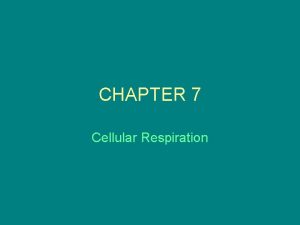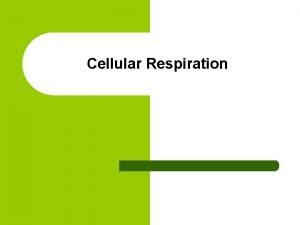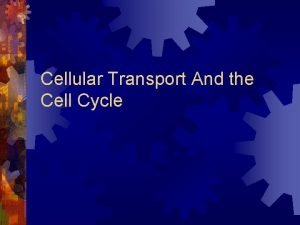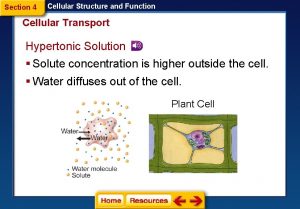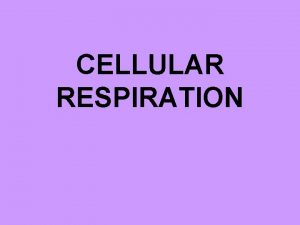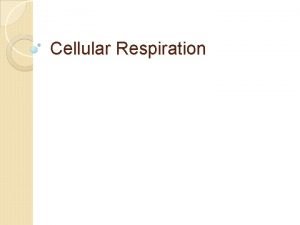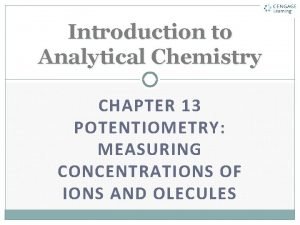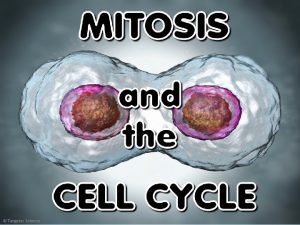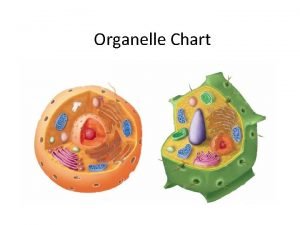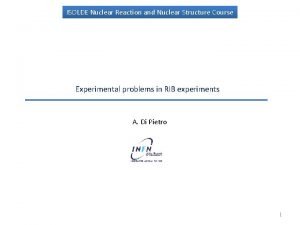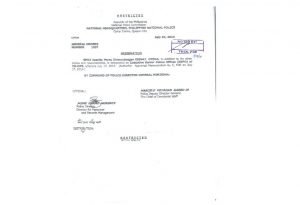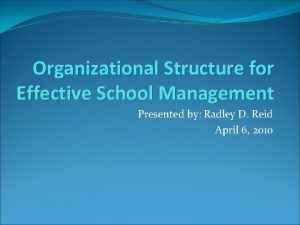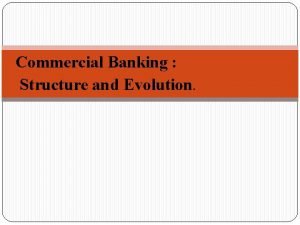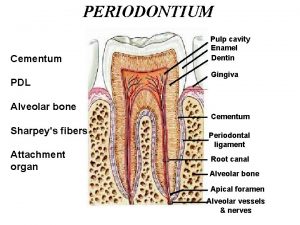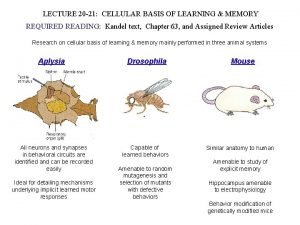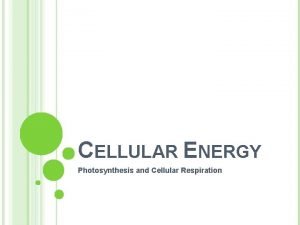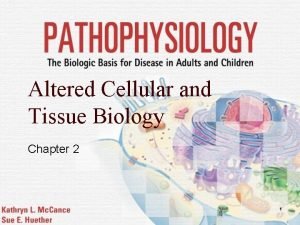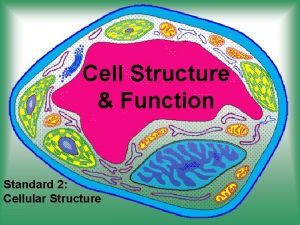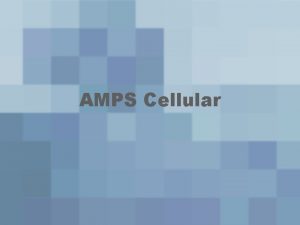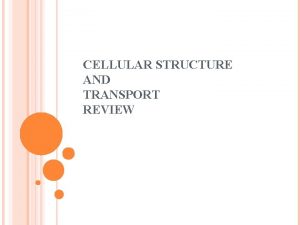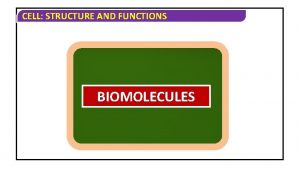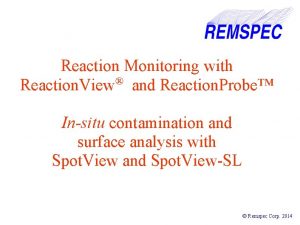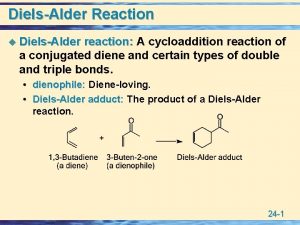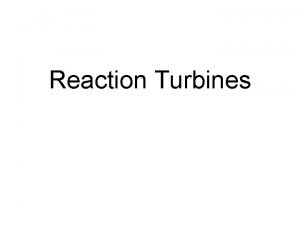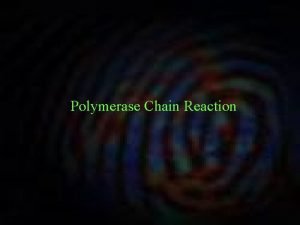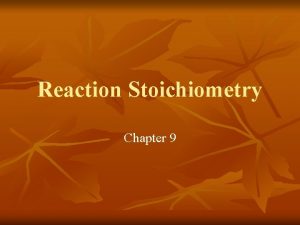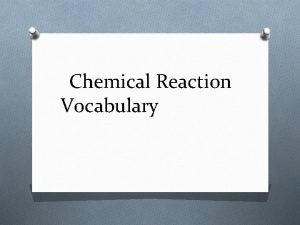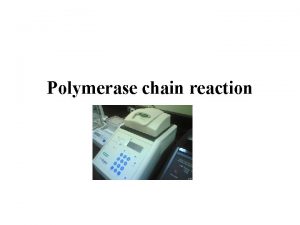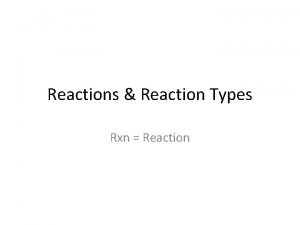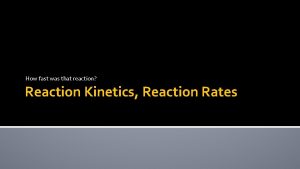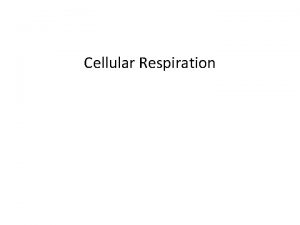Cell Structure and Functions Cellular reaction Introduction Cell























































- Slides: 55

Cell Structure and Functions & Cellular reaction

Introduction • Cell theory states that all organisms are made up of cells and that cells come only from pre-existing cells. • A cell is: • the smallest unit of life • marks the boundary between the nonliving and the living • contain the same components despite variety of form and function • Organelles are membrane-bound structures within a cell that are specialized to perform a distinct process within a cell. 2


Cells, tissues, organs & organ system

Specialized Cells 5

Are viruses living? • Viruses aren’t made of cells. • They cannot grow and divide by themselves. • Viruses can only reproduce if they take over a host cell and steal its energy and materials 6

4. 2 Prokaryotic and eukaryotic cells Cells can be categorized in two different ways according to structure: Prokaryotes Eukaryotes • Prokaryotes Usually unicellular Usually multicellular • Eukaryotes No true nucleus Membrane bounded nucleus Organelles absent Organelles present Smaller ribosomes Larger ribosomes Example: bacteria, archaea Example: animal, plant, fungi, algae 7


Prokaryotic Cells The majority of prokaryotic cells share these characteristics: • Plasma membrane - forms a barrier around the cell • Cell wall - lies outside the plasma membrane provides additional support to the cell. • DNA - the genetic material of prokaryotes, is located in the cytoplasm, in an area called the nucleoid • Ribosomes - make proteins in the cytoplasm. • Capsule - in some bacteria, the cell wall is surrounded by another layer called capsule • Flagella – involved in movement 9

Eukaryotic cells Eukaryotes have the following characteristics: • Nucleus - stores genetic information • Plasma membrane - encloses the cell and separates it from its environment • Internal membranes - such as endoplasmic reticulum and Golgi apparatus that create specialized compartments inside the cells • Cytoskeleton - made of proteins that reinforces the cells and controls cellular movements • Ribosomes - makes protein in the cytoplasm • Mitochondria - combine oxygen and food to transfer the energy from food to a form that cells can use • Chloroplasts - use energy from sunlight plus water and carbon dioxide to make food. (found only in the cells of plants and algae. ) • Cell wall - outside of their plasma membrane. ( found only in the cells of plants, algae, and fungi; animal cells just have a plasma membrane) 10

Eukaryotic Cell

Eukaryotic Cells Feature Animal Plant Cell Wall Absent Present Vacuole Absent Present Chloroplast Absent Present Food Reserve Glycogen Starch Shape Not fixed Fixed Cell Prokaryote Eukaryote Plant Animal 12

13

Plasma membrane • Plasma membrane (or cell membrane): The membrane that encloses and defines all cells as separate from their environment. Functions: • It separates the chemical reactions occurring inside the cell from the chemicals outside the cell. • Regulates the entrance and exit of molecules into and out of the cytoplasm. 14

Plasma membrane Structure: Plasma membrane has mainly three components: 1. Phospholipid bilayer • forms the basic foundation • each phospholipid molecule has a hydrophilic head that’s attracted to water and a hydrophobic tail that repels water. • the hydrophilic heads point toward the watery environments outside and inside the cell, sandwiching the hydrophobic tails between them to form the phospholipid bilayer. 2. Carbohydrates • minor component • attached to the outer surface of the membrane 3. Cholesterol • makes the membrane more stable Plasma membranes are made of several different components, much like a mosaic work of art. Because membranes are a mosaic, and because they’re flexible and fluid, the structure is called a fluid-mosaic structure. 15

Plasma membrane 16

Plasma membrane Transport across membrane: • Small, hydrophobic molecules such as oxygen and carbon dioxide can easily pass across membranes. • Hydrophilic and larger molecules such as ions , food, hormones can’t get through the tails by themselves, so they need help to cross. • Channel proteins, carrier proteins and receptor proteins help transport molecules from one side of the membrane to the other. • Because the plasma membrane is choosy about what substances can pass through it, it’s said to be selectively permeable 17

Transport across membrane: There are generally two modes of transport: 1. Passive transport - requires no energy on the part of the cell. Example: diffusion and osmosis 2. Active transport - requires energy from the cell to move molecules that can’t cross the phospholipid bilayer on their own. • Proteins carrying out this function are called pumps. 18

Cytoplasm • The jelly like fluid inside a cell is called cytoplasm • Contains all the organelles • Mainly composed of water, salts, and proteins. • Cytoskeleton is a network of fibers extending throughout the cytoplasm. Elements of the cytoskeleton reinforce, organize, and move cell structures, anchoring many organelles 19

Nucleus One of the most important organelle in a cell. Structure: • Nuclear envelope - a membrane separating nucleus from the cytoplasm - controls the passage of molecules between the nucleus and cytoplasm. • Nucleoplasm - liquid that fills the inside of the nucleus. • Chromosome - composed of DNA molecules associated with proteins Function: • Stores the cell's genetic information in the form of DNA • DNA holds the instructions for how the cell should work. 20

Ribosomes Non-membranous organelles responsible for the synthesis of proteins from amino acids. Structure and function: • They are composed of RNA and proteins. • Each ribosome is composed of two subunits—a large one and a small one. Two types of ribosomes: • Bound ribosomes: Attached to the endoplasmic reticulum and are active sites of protein production. • Free ribosomes: Found floating freely in the cytoplasm wherever proteins are being assembled 21

Endoplasmic reticulum (ER) • ER is a series of canals that connects the nucleus to the cytoplasm of the cell. • The space inside the compartment is the site where many new polypeptide chains are modified. • Two kinds of ER: • Rough ER - Ribosomes on surface give it a rough appearance • Smooth ER - No ribosomes on surface Smooth ER 22

Endoplasmic reticulum Functions of ER Smooth ER 1. Synthesizes lipids 2. Metabolizes carbohydrates 3. Detoxifies drugs and poisons 4. Stores calcium ions Rough ER Protein synthesis, protein folding, quality control and despatch. 23

Golgi bodies • Golgi is a series of flattened membrane compartments, whose purpose is to process and package proteins produced in-the rough endoplasmic reticulum. • The processed molecules are packaged into membrane vesicles, then targeted and transported to their final destinations. Functions of the Golgi apparatus • Modifies products of the ER • Manufactures certain macromolecules • Sorts and packages materials into transport vesicles. 24

Vesicles Small, membrane-enclosed, sac-like structures Two main types are: i) Lysosomes: Digestion & recycling centers • Takes part in intracellular digestion • Contains powerful enzymes that can break down carbohydrates, proteins, nucleic acids, and lipids • Lysosomes break down worn out cell parts or molecules so they can be used to build new cellular structures. ii) Peroxisomes: • Contain enzymes that digest fatty acids and amino acids. • Peroxisome enzymes detoxifies harmful substances in the cell 25

Mitochondria Mitochondrion (plural, mitochondria) is a type of organelle that specializes in making ATP (molecule used by cells as main energy source). Structure • Double membraned organelle • Inner membrane contains many folds called cristae that increases surface area for chemical reactions • The fluid inside is called matrix Function • Site of energy production • Cells that have a very high demand for energy tend to have many mitochondria e. g. liver needs more because needs more energy. 26

Plastid Doubled membraned 'sac-like' organelles, generally involved in either the manufacture or storage of food in plants Three kinds: 1. Chloroplast: contains green pigment – carries out photosynthesis 2. Leucoplast: contains no pigment so is colorless – involved in synthesis or storage 3. Chromoplast: contains yellow, orange and/or red pigments: accessory photosynthetic pigments 27

Cilia and Flagella Cilia • Cilia (singular, cilium) are short, hair-like structures that project from the surface of some cells. • Mainly found in eukaryotic cells. • The coordinated waving of many cilia propels cells through fluid, and stirs fluid around stationary cells. Flagella • Flagella are long hair-like structure and present in both prokaryotic and eukaryotic cells. • In prokaryotes flagellum projects from the cell wall and enables a cell to move. • In eukaryotes, flagellum structure is different from the prokaryotic cells and whip back and forth to propel cells such as sperm through fluid. 28

Cell Respiration & The Energy of Life

• The living cell is a miniature chemical factory where thousands of reactions occur • The cell extracts energy and applies energy to perform work • Some organisms even convert energy to light, as in bioluminescence • Metabolism is the totality of an organism’s chemical reactions • A metabolic pathway begins with a specific molecule and ends with a product • Each step is catalyzed by a specific enzyme 30

Metabolic Pathways • Metabolic pathways are of two types: Catabolic and Anabolic • Catabolic pathways release energy by breaking down complex molecules into simpler compounds Example: Cellular respiration - the breakdown of glucose in the presence of oxygen • Anabolic pathways consume energy to build complex molecules from simpler ones Example - synthesis of protein from amino acids

Cellular Respiration • The process by which living cells break down glucose molecules and release stored energy. • Occurs in mitochondria. • Burning of Glucose also called Oxidation 32

Breathing vs. Cellular Respiration 33

ATP-The major energy currency • ATP (adenosine triphosphate) is the cell’s energy currency • ATP is composed of ribose (a sugar), adenine (a nitrogenous base), and three phosphate groups • This substance can quickly store energy and release energy 34

ATP-The major energy currency Energy transfer by ATP. • ATP has a complex structural formula. A ~ ~. • The A stands for adenosine and each stands for one phosphate group. • The wavy lines (~) represent high-energy phosphate bonds. • Breaking of each bond release 7 kilo-calories of energy. 35


Energy transfer by ATP. § Most of the energy-consuming reactions in cells are powered by the conversion of ATP to ADP § Energy required for the nerve signals, the movement of muscles, the synthesis of protein, and cell division §ATP is a renewable resource that is regenerated by addition of a phosphate group to adenosine diphosphate (ADP) • The energy to phosphorylate ADP comes from catabolic reactions in the cell 37

The Role of ATP in Cellular Respiration • ATP-ADP cycle connects with the process of cellular respiration. • Every molecule of Glucose is oxidized to 38 molecules of ATP. Store Energy Reaction Summary Glucose + 6 O 2 + 38 ADP + 38 P --- 6 CO 2 + 6 H 2 O + 38 ATP 38

Types of respiration 1. Aerobic respiration: • Reaction that needs free oxygen • Releases relatively large amount of energy in cells by the breakdown of food substances in the presence of oxygen • Example: cellular respiration 2. Anaerobic respiration: • Reaction that does not need oxygen. • Releases relatively small amount of energy in cells by the breakdown of food substances in the absence of oxygen. • Example: Alcohol fermentation in plants and yeasts and lactic acid fermentation in muscles 39

Aerobic vs Anaerobic reaction

Anaerobic Respiration Alcohol fermentation • Glucose is converted to ethanol and carbon dioxide glucose → ethanol + carbon dioxide + energy • Occurs in plant cells and some microorganisms • Anaerobic respiration in yeast is used during brewing and bread-making – bubbles of carbon dioxide expand the dough and help the bread rise • Ethanol is the alcohol found in alcoholic drinks like beer and wine. 41

Anaerobic Respiration- Lactic acid fermentation • During periods of heavy physical activity, muscle cells may not be able to get oxygen fast enough to carry out the usual aerobic cellular respiration. • When this occurs, muscle cells begin to respire anaerobically: glucose → lactic acid + energy • There is a build-up of lactic acid in the muscles during vigorous exercise. • This lactic acid needs to be oxidised to carbon dioxide and water later. • This causes an oxygen debt that needs to be ‘repaid’ after the exercise stops. • This is why we keep on breathing deeply for a few minutes after we have finished exercising. 42

Comparison between aerobic and anaerobic respiration Aerobic Anaerobic Oxygen Needed Not needed Glucose breakdown Complete Incomplete End product(s) Carbon dioxide and water Animal cells: lactic acid. Plant cells and yeast: carbon dioxide and ethanol Energy released Relatively large amount Relatively small amount 43

Enzymes • Enzymes are complex chemicals that control reactions in living cells. • They are biochemical catalysts speeding up reactions that would otherwise happen too slowly. • The chemical in which an enzyme works on is called its substrate. • The enzyme binds to its substrate, forming an enzymesubstrate complex. • The active site is the region on the enzyme where the substrate binds. • Once a reaction has occurred, the complex breaks up into products and enzyme. 44

Substrates Products E-S complex Active site Enzyme 45

Figure 8. 15 -1 1 Substrates enter active site. 2 Substrates are held in active site by weak interactions. Substrates Enzyme-substrate complex Active site Enzyme 46

Figure 8. 15 -2 1 Substrates enter active site. 2 Substrates are held in active site by weak interactions. Substrates Enzyme-substrate complex Active site can 3 lower EA and speed up a reaction. Active site Enzyme Substrates are 4 converted to products. 47

Figure 8. 15 -3 1 Substrates enter active site. 2 Substrates are held in active site by weak interactions. Substrates Enzyme-substrate complex Active site can 3 lower EA and speed up a reaction. 6 Active site is available for two new substrate molecules. Enzyme 5 Products are released. Substrates are 4 converted to products. Products 48

Photosynthesi s • Photosynthesis is the process that converts solar energy into chemical energy in the form of glucose • Directly or indirectly, photosynthesis nourishes almost the entire living world • Photosynthesis occurs in plants, algae and some prokaryotes • These organisms feed not only themselves but also most of the living world 49

Figure 10. 2 (b) Multicellular alga (a) Plants (d) Cyanobacteria (c) Unicellular protists 40 m 10 m (e) Purple sulfur bacteria 1 m 50

Photosynthesis • AUTOTROPHS: Organisms that can produce their own food from the substances available in their surroundings using light (photosynthesis) or chemical energy (chemosynthesis). • HETEROTROPHS: Heterotrophs cannot synthesize their own food and rely on other organisms -- both plants and animals -- for nutrition. 51

Photosynthesis is the process that converts • Leaves are the major locations solar energy into chemical energy in the form of of photosynthesis glucose • Their green color is from chlorophyll, the green üThe carbon and oxygen for the sugars come pigment within chloroplasts from carbon dioxide in the Earth’s atmosphere. • Chlorophyll captures the light üThe hydrogen for the sugars comes from energy required for water found in the soil. photosynthesis. ü The energy to build the sugars comes from • CO 2 enters and O 2 exits the Sun leaf through microscopic pores called stomata 52

53

Photosynthesis vs Respiration Photosynthesis is the process by which plants prepare their own food using carbon dioxide and water in the presence of sunlight and chlorophyll. Respiration is the process by which the food is burnt in the presence of oxygen to release energy. During photosynthesis, CO 2 is absorbed and O 2 is released. During respiration, O 2 is absorbed and CO 2 is released. Anabolic process Catabolic process Occurs only in plants and some photosynthetic bacteria Occurs in all living organisms 54

 Cell reaction
Cell reaction Cellular respiration redox
Cellular respiration redox Chemical equation for cellular respiration
Chemical equation for cellular respiration Redox reaction in cellular respiration
Redox reaction in cellular respiration Overall reaction of cellular respiration
Overall reaction of cellular respiration Overall reaction of cellular respiration
Overall reaction of cellular respiration Cellular transport and the cell cycle
Cellular transport and the cell cycle Chapter 7 section 4 cellular transport
Chapter 7 section 4 cellular transport E1cb elimination reaction
E1cb elimination reaction Bomb power
Bomb power Functions of cellular respiration
Functions of cellular respiration All cells must contain
All cells must contain Where in the cell does cellular respiration occur
Where in the cell does cellular respiration occur Where in the cell does cellular respiration occur
Where in the cell does cellular respiration occur Rate law
Rate law Leukoerythroblastic reaction vs leukemoid reaction
Leukoerythroblastic reaction vs leukemoid reaction Intro paragraph layout
Intro paragraph layout Evaluating functions
Evaluating functions Evaluating functions and operations on functions
Evaluating functions and operations on functions What are redox reactions examples
What are redox reactions examples Balancing oxidation reduction reactions
Balancing oxidation reduction reactions Calomel electrode
Calomel electrode Cell cycle
Cell cycle Structure of animalcell
Structure of animalcell Fun fact about vacuole
Fun fact about vacuole Cell organelle graphic organizer answer key
Cell organelle graphic organizer answer key Cell organelles graphic organizer answer key
Cell organelles graphic organizer answer key Reaction structure
Reaction structure What is the organizational structure of the pnp
What is the organizational structure of the pnp Parts of a bean flower
Parts of a bean flower Chapter 11 structure and functions of the executive branch
Chapter 11 structure and functions of the executive branch Management structure of a school
Management structure of a school Banking structure
Banking structure Chapter 11 structure and functions of the executive branch
Chapter 11 structure and functions of the executive branch Advantages and disadvantages of diaphragm cell process
Advantages and disadvantages of diaphragm cell process Linear chromosomes in eukaryotes
Linear chromosomes in eukaryotes Difference of animal cell and plant cell
Difference of animal cell and plant cell Vacuole function
Vacuole function Primary source batteries
Primary source batteries Whats the difference between plant and animal cells
Whats the difference between plant and animal cells Events of the cell cycle
Events of the cell cycle Life
Life Chapter 4 cell theory and cell study
Chapter 4 cell theory and cell study Idealized animal cell and plant cell
Idealized animal cell and plant cell Walker cell and hadley cell
Walker cell and hadley cell Cell cycle and cell division
Cell cycle and cell division Plant vs animal cells venn diagram
Plant vs animal cells venn diagram Phases of cell cycle
Phases of cell cycle Galvanic vs electrolytic cell
Galvanic vs electrolytic cell Flexible covering of an animal cell
Flexible covering of an animal cell Complimentary processes
Complimentary processes Photosynthesis and cellular respiration vocabulary
Photosynthesis and cellular respiration vocabulary Acellular cementum and cellular cementum
Acellular cementum and cellular cementum Ltp
Ltp Cellular respiration equation
Cellular respiration equation Mosby items and derived items
Mosby items and derived items



